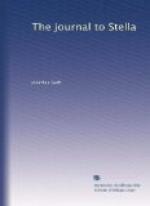34 See Letter 9, note 4.
35 “As I hope to be saved;” a favourite phrase in the Journal.
36 See Letter 7, note 12.
37 This statement receives some confirmation from a pamphlet published in September 1710, called “A Condoling Letter to the Tatler: On Account of the Misfortunes of Isaac Bickerstaf Esq., a Prisoner in the —— on Suspicion of Debt.”
38 Dr. Lambert, chaplain to Lord Wharton, was censured in Convocation for being the author of a libellous letter.
39 Probably the same person as Dr. Griffith, spoken of in the Journal for March 3, 1713,—when he was ill,—as having been “very tender of” Stella.
40 See Letter 9, note 22.
41 Vexed, offended. Elsewhere Swift wrote, “I am apt to grate the ears of more than I could wish.”
42 Ambrose Philips, whose Pastorals had been published in the same volume of Tonson’s Miscellany as Pope’s. Two years later Swift wrote, “I should certainly have provided for him had he not run party mad.” In 1712 his play, The Distrest Mother, received flattering notice in the Spectator, and in 1713, to Pope’s annoyance, Philips’ Pastorals were praised in the Guardian. His pretty poems to children led Henry Carey to nickname him “Namby Pamby.”
43 An equestrian statue of William iii., in College Green, Dublin. It was common, in the days of party, for students of the University of Dublin to play tricks with this statue.
44 Lieutenant-General Richard Ingoldsby (died 1712) was Commander of the Forces in Ireland, and one of the Lords Justices in the absence of the Lord Lieutenant.
45 This seems to have been a mistake; cf. Journal for July 13, 1711, Alan Brodrick, afterwards Viscount Midleton, a Whig politician and lawyer, was made Chief Justice of the Queen’s Bench in Ireland in 1709, but was removed from office in June 1711, when Sir Richard Cox succeeded him. On the accession of George I. he was appointed Lord Chancellor for Ireland. Afterwards he declined to accept the dedication to him of Swift’s Drapiers Letters, and supported the prosecution of the author. He died in 1728.
46 Robert Doyne was appointed Chief Baron of the Exchequer in Ireland in 1695, and Chief Justice of the Common Pleas in 1703. This appointment was revoked on the accession of George I.
47 See Letter 9, note 12.
48 Of the University of Dublin.
49 See Letter 2, note 18 and Letter 3, note 4. Sir Thomas Frankland’s eldest son, Thomas, who afterwards succeeded to the baronetcy, acquired a fortune with his first wife, Dinah, daughter of Francis Topham, of Agelthorpe, Yorkshire. He died in 1747.
50 See Letter 8, note 21.
51 see Letter 4, note 15.
52 Mary, daughter of Sir John Williams, Bart., and widow of Charles Petty, second Lord Shelburne, who died in 1696. She had married, as her second husband, Major-General Conyngham, and, as her third husband, Colonel Dallway.




